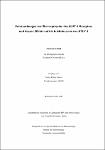Untersuchungen zur Überexpression des GLUT-1-Rezeptors und dessen Effekte auf die Infektionsrate von HTLV-1
Amler, Anna-Klara
Mit dem humanen T-lymphotropen Virus (HTLV) sind weltweit 15-20 Millionen Menschen in-fiziert, wobei es in einigen Gebieten eine Prävalenz von bis zu 35% besitzt. Die Infektion mit dem Virus führt in 3-5% der Infizierten zur HTLV-assoziierten Myelopathie/ tropischen spasti-schen Paraparese (HAM/TSP) und/ oder zur adulten T-Zell-Leukämie (ATL). In vivo erfolgt die Transmission hauptsächlich durch Zell-assoziiertes Virus, z.B. bei Brustfütterung, sexuellem Kontakt oder Blutkontamination. Obwohl die Infizierbarkeit vieler Zelllinien in vitro mittels Co-Kultivierung mit HTLV-1 produzierenden Zellen bereits gezeigt wurde, ist eine Infektion durch freies Virus nicht einfach zu erreichen. Im Rahmen dieser Arbeit sollte untersucht werden, ob eine Überexpression des putativen HTLV-1-Rezeptors GLUT-1 in zwei verschiedenen Zelllinien zu einer Erhöhung der Infektionsrate durch freies Virus führt. Dazu wurden zunächst die HTLV-1-Sequenzen für das p19 Matrix- und das p24 Capsid-Protein in ein eukaryontisches Expressionskonstrukt unter Einfügen des V5-Tags kloniert, um im Westernblot nachweisbare Positivkontrollen, sowohl mittels HTLV-1-spezifischen Serums als auch eines kommerziellen monoklonalen α-V5-Antikörpers, zu erhalten. Weiterhin wurde ausgehend von einer Hybridoma-Zelllinie ein monoklonaler α-Tax-Antikörper aufgereinigt und erfolgreich zur Detektion der HTLV-Replikation in Zellen eingesetzt. Im Infektionsexperiment sollten Zelllinien, die GLUT-1 überexprimieren, zellfrei infiziert wer-den. Für die beiden dafür verwendeten Zelllinien HOS (humanes Osteosarkom) und ARPE-19 (humanes pigmentiertes Retina-Epithel) wurde bereits die Infizierbarkeit mit HTLV berichtet. Die Überexpression von GLUT-1 wurde mittels Transfektion eines entsprechenden Plasmids erreicht und konnte mit Hilfe der Fluoreszenzmikroskopie sowie des Western Blots nachgewie-sen werden. Für den Infektionsversuch wurden Viren in chronisch infizierten MT-2-Zellen und in transient mit einem Molekularklon transfizierten HEK-293T-Zellen produziert und aufkonzentriert, sodass eine infektiöse, hochtritrige Suspension genutzt werden konnte. Mittels Realtime-PCR wurde die Infektion beider Zelllinien nachgewiesen, wobei zuvor nur für die Zelllinie HOS eine zellfreie Infektion beschrieben worden war. Hier konnte erstmals auch die zellfreie Infektion von ARPE-19-Zellen gezeigt werden. Durch Messung der Reversen-Transkriptase-Aktivität im Überstand der infizierten Zellen, ein Marker für die Freisetzung von neuen viralen Partikeln, konnte gezeigt werden, dass die Infektion innerhalb des Inkubationszeitraums bei beiden Zelllinien nicht pro-duktiv war. Die Überexpression von GLUT-1 hat nach den Ergebnissen dieser Arbeit keinen erkennbaren Einfluss auf die Infektionsrate von HTLV in HOS- und ARPE-19-Zellen. The human T-lymphotropic virus (HTLV) infects 15-20 million people worldwide. In some re-gions this prevalence reaches up to 35%. The infection with the virus leads in 3-5% cases of in-fected individuals to the HTLV-associated myelopathy/ tropical spastic paraparesis (HAM/TSP) and/ or to the adult T-cell leukemia (ATL). In vivo the virus is mainly transmitted via cell-associated contacts, i.e. breastfeeding, sexual contacts or blood contamination. Although it has been shown that many established cell lines can be infected with HTLV-1 via cocultivation with virus producing cells, an infection with free virions is not easy to achieve. In this thesis the goal was to examine, whether an overexpression of the putative HTLV-1 recep-tor GLUT-1 increases the infection rate by free virions. In that aim, the HTLV-1 sequences of the p19 matrix and the p24 capsid protein were cloned into a eukaryotic expression construct while adding a V5 tag, so that positive controls were gained, which can be used for a Western blot both with an HTLV-1 specific serum and a commercial monoclonal α-V5 antibody. Fur-thermore a monoclonal α-Tax antibody was purified from a hybridoma cell line and used for detection of the replication of HTLV in cells. Purpose of the infection experiment was to examine whether GLUT-1 overexpressing cells are able to be cell-free infected. For this experiment the cell lines HOS (human osteosarcoma) and ARPE-19 (human retinal pigment epithelium) were used, which have been reported as infectable with HTLV. The overexpression of GLUT-1 was attained by transfection of a corresponding plasmid and detected by fluorescence microscopy and Western blot. For the infection experiment virions were produced in chronically infected MT-2 cells and in transient with a molecular clone transfected HEK-293T cells and concentrated, so that an infec-tious high titring suspension could be used. Using real time PCR infection of both cell lines was proved, while only cell-free infection of HOS cells has been reported so far. Here the cell-free infection of ARPE-19 cells could be demonstrated for the first time. By determining the reverse transcriptase activity in the supernatants of the infected cells, which is a marker of the release of new viral particles, we were able [???] to show that the infection of both cell lines was non-productive within the incubation time. Based on the results of this thesis, the overexpression of GLUT-1 has no observable effect on the infection rate of HTLV in HOS and ARPE-19 cells.
Dateien zu dieser Publikation
Keine Lizenzangabe

